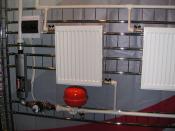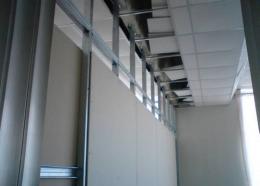Search
Login
Recommended
Installation of drywall on a concrete wall, how to properly install drywall, installation technology
Plasterboard is a material that will allow you to level and prepare the walls for further finishing in any room of a wooden, brick or panel house quite independently, quickly and easily, with minimal time and money. How to properly install drywall on the walls and ceiling, so that they turn out to be not only smooth, but also durable, we will tell in our article.
Content:
- Drywall: scope
- Drywall: what you need to know for installation
- Drywall: wall mounting technology video video
- Drywall: ceiling mount technologyvideo
Drywall: scope
Everyone is very well aware of such a pliable and versatile material that is actively used in the construction and decoration of rooms, such as drywall. And there is, perhaps, not a single apartment in which repairs have been made in the last 20 years and without using drywall.
What kind of miracle is this?

Drywall this is a sheet of gypsum board measuring 3m by 1.2m or 2.5m by 1.2m, on both sides and from the end part pasted over with a layer of cardboard, hence its name. It is practically 100% environmentally friendly material, about 93% of the entire sheet is gypsum, 6% is cardboard, 1% are binders, water and additives. But, even when using various kinds of additives to give moisture and heat resistance to gypsum, gypsum board is the most environmentally friendly material: non-toxic, breathable, if necessary, moisture-resistant and non-combustible. It is these properties that allow you to use drywall in any room of the apartment: kitchen, bathroom, nursery or bedroom.
Why is gypsum board so actively used in our apartments:
- as a component of a puff pie when warming walls and ceilings.

- for the quick construction of partitions, niches, multi-level structures, both on the walls and on the ceiling, both functional and decorative purposes.

- for fast, with significant cost savings, alignment of walls and ceilings: using the frame or directly on the wall, gluing a sheet of drywall on the glue (dry plaster).
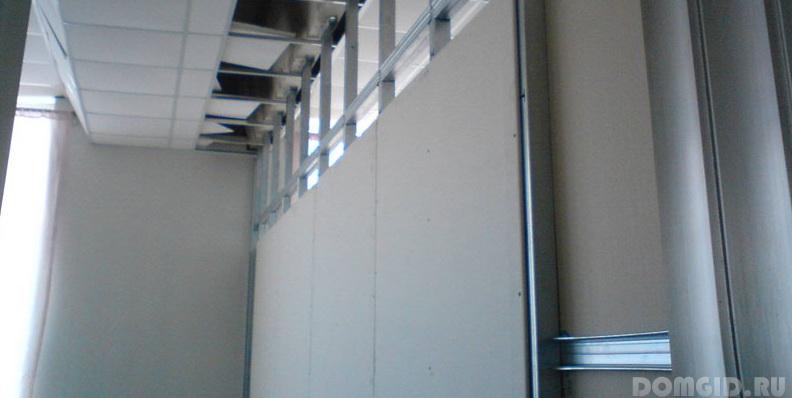
Drywall: what you need to know for installation
Despite the fact that the gypsum board is quite easily mounted on walls and ceilings, and the installation is available, in principle, if not for everyone, then a person with hands is so certain, there are some points that you need to know and take into account without fail so that the design It turned out to be durable and beautiful.
Drywall is mounted in several ways:
- on glue (on the legs),directly to the surface of the wall, ceiling, for its alignment, followed by finishing: this method is a variant of dry plaster. It is used on all types of surfaces, except wooden: brick, concrete walls, foam block walls.
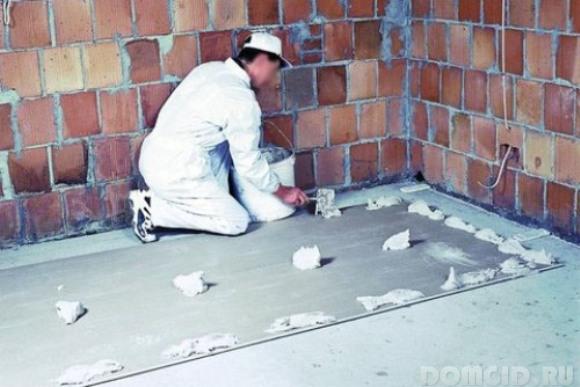
- to the frame.To the surface of the wall, ceiling, with subsequent finishing. It is used on all types of surfaces, including wooden walls for insulation and dry plaster in wooden houses. At the same time, the frame can be both wooden, metal.
Most often wood frame use because of cost savings, tk. wooden bars are cheaper, their installation does not use suspensions and other elements required for the construction of a metal frame.
The metal frame, consisting of various kinds of galvanized profiles, suspensions, connectors (crabs), unlike wooden, more durable, versatile, not affected by moisture (i.e., does not deform, does not dry out, as it can be with a wooden frame), not rotting, not combustible.
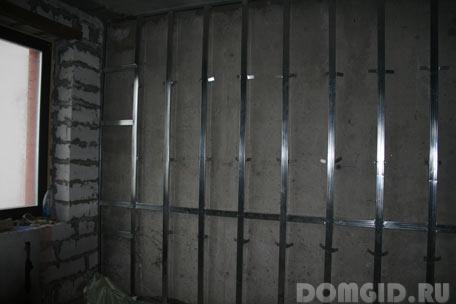
Plasterboard sheets mounted on a frame
- vertically, in a run-up, according to technology in 2 layers (especially if it is interior partitions, dry plaster).
- joints of drywall sheets should be located on the frame element and screwed with screws.
- the joints are glued with a docking tape.
- externally, the corners resulting from the installation of drywall structures are reinforced with a perforated corner.
But these are all common points, we turn to the details.
Drywall: wall mounting technology
The technology for installing drywall on walls is the same for all types of walls in that:
- the frame is set by level.
- using guide profiles, which, first, are attached directly to the surface of the wall, floor, ceiling along the marked perimeter.
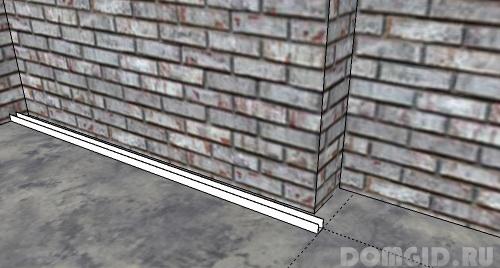
- using the rack profile, as the supporting element of the frame, which is attached to the leveling wall, using direct suspensions, according to the level.
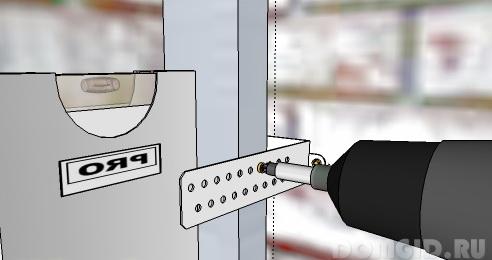
The distance between the elements of the frame is 40-60 cm. (Because the sheet of drywall is 1.2 m wide, and the joints of the sheets must be fixed to the frame).

- for greater strength, the frame can be supplemented with guide profiles.


- drywall to the frame is attached with a gap of 1-1.5 cm from the floor and ceiling.
Features of the installation of gypsum board, more precisely, the installation of the frame on the walls of different materials, are as follows:
- concrete wall:drywall to the concrete wall is mounted without features. Holes are drilled with a puncher, according to the marking, the frame is fixed with a dowel with nails (60 mm).
- Brick wall:the installation of drywall on a brick wall is similar to concrete, but taking into account the condition and quality of the brick used in masonry. For fastening the frame for drywall constructions in an old or brick wall made of hollow bricks, dowel nails from 80 mm are used.
- wall of foam blocks:the frame is fastened either using special plugs for foam blocks or fastened long, 10 cm, with screws, directly to the wall, without first drilling a hole.
- a wall of wood in a wooden house: the frame is mounted on self-tapping screws or nails, but a movable frame is constructed on the curtains, with a stroke of 2.5 to 6 cm.
Drywall: ceiling mount technology
The installation of drywall on the ceiling is similar to the construction of the frame for the walls. But it has a more cellular appearance, for greater strength.

And you can verify this by watching the video:


